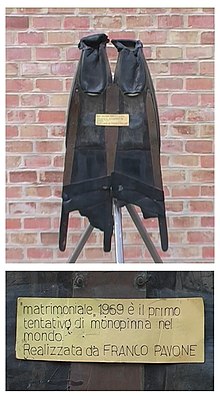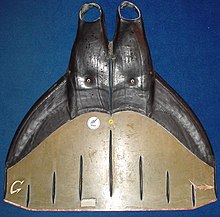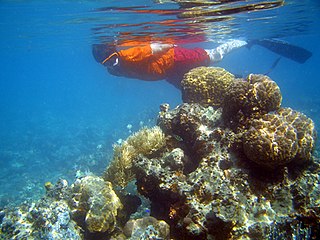
Snorkeling is the practice of swimming face down on or through a body of water while breathing the ambient air through a shaped tube called a snorkel, usually with swimming goggles or a diving mask, and swimfins. In cooler waters, a wetsuit may also be worn. The snorkel may be an independent item or integrated with the mask. The use of this equipment allows the snorkeler to observe the underwater environment for extended periods with relatively little effort, and to breathe while face-down at the surface.

Swimfins, swim fins, diving fins, or flippers are finlike accessories worn on the feet, legs or hands and made from rubber, plastic, carbon fiber or combinations of these materials, to aid movement through the water in water sports activities such as swimming, bodyboarding, bodysurfing, float-tube fishing, kneeboarding, riverboarding, scuba diving, snorkeling, spearfishing, underwater hockey, underwater rugby and various other types of underwater diving.

Finswimming is an underwater sport consisting of four techniques involving swimming with the use of fins either on the water's surface using a snorkel with either monofins or bifins or underwater with monofin either by holding one's breath or using open circuit scuba diving equipment. Events exist over distances similar to swimming competitions for both swimming pool and open water venues. Competition at world and continental level is organised by the Confédération Mondiale des Activités Subaquatiques (CMAS). The sport's first world championship was held in 1976. It also has been featured at the World Games as a trend sport since 1981 and was demonstrated at the 2015 European Games in June 2015.
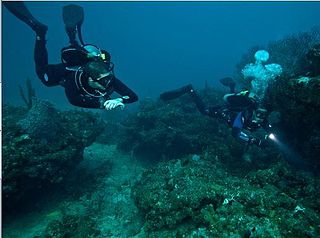
Finning techniques are the skills and methods used by swimmers and underwater divers to propel themselves through the water and to maneuver when wearing swimfins. There are several styles used for propulsion, some of which are more suited to particular swimfin configurations. There are also techniques for positional maneuvering, such as rotation on the spot, which may not involve significant locational change. Use of the most appropriate finning style for the circumstances can increase propulsive efficiency, reduce fatigue, improve precision of maneuvering and control of the diver's position in the water, and thereby increase the task effectiveness of the diver and reduce the impact on the environment. Propulsion through water requires much more work than through air due to higher density and viscosity. Diving equipment which is bulky usually increases drag, and reduction of drag can significantly reduce the effort of finning. This can be done to some extent by streamlining diving equipment, and by swimming along the axis of least drag, which requires correct diver trim. Efficient production of thrust also reduces the effort required, but there are also situations where efficiency must be traded off against practical necessity related to the environment or task in hand, such as the ability to maneuver effectively and resistance to damage of the equipment.

Natalia Vadimovna Molchanova was a Russian champion free diver, multiple world record holder, and the former president of the Russian Free Dive Federation. She has been described as "possibly the world’s greatest freediver".
Norbert Oscar Gugen co-founded the British Sub-Aqua Club, "the largest and most successful diving club in the world", and the partnership E. T. Skinner & Co. Ltd., which became Typhoon International, "the world’s largest manufacturer of drysuits". Born Norbert Oscar Gugenbichler in Paris with dual Austrian and French nationality, he was naturalised British as "Manager and Secretary " on 29 August 1951.

A snorkel is a device used for breathing atmospheric air when the wearer's head is face downwards in the water with the mouth and the nose submerged. It may be either a separate unit, or integrated into a swimming or diving mask. The integrated version is only suitable for surface snorkeling, while the separate device may also be used for underwater activities such as spearfishing, freediving, finswimming, underwater hockey, underwater rugby and for surface breathing while wearing scuba equipment. A standard snorkel is a curved tube with a shape usually resembling the letter "L" or "J", fitted with a mouthpiece at the lower end and made from plastic, synthetic elastomers, rubber, or light metal. The snorkel may have a loop or a clip to attach it to the head strap of the diving mask or swimming goggles, or may be tucked between the mask-strap and the head. Some snorkels are fitted with a float valve at the top to prevent flooding if the top opening is immersed, and some are fitted with a water trap and purge valve, intended for draining water from the tube.
Underwater sports is a group of competitive sports using one or a combination of the following underwater diving techniques - breath-hold, snorkelling or scuba, usually including the use of equipment such as diving masks and fins. These sports are conducted in the natural environment at sites such as open water and sheltered or confined water such as lakes and in artificial aquatic environments such as swimming pools. Underwater sports include the following - aquathlon, finswimming, freediving, spearfishing, sport diving, underwater football, underwater hockey, underwater ice hockey, underwater orienteering, underwater photography, underwater rugby, underwater target shooting and underwater video.
The Texas Finswimming Association (TFA) is the official governing body for competitive and recreational finswimming in Texas. The TFA consists of competitive teams, high schools, colleges, individual athletes, supporters, and others who are interested in advancing the sport of finswimming in the Lone Star State.
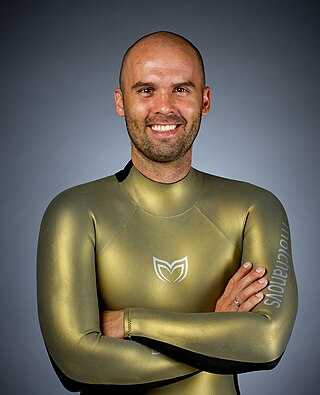
Alexey Molchanov is a Russian champion freediver, 34-time world champion, world record holder, and freediving promoter. He is also president of the "Freediving Federation" association, president of AIDA Russia, head of freediving school named in honor of Natalia Molchanova, and designer and engineer of the freediving equipment brand Molchanovs. Alexey is a son of Natalia Molchanova – multiple champion and world record holder in freediving.
The Lunocet is a biomimetic monofin intended to reduce drag and augment human swimming ability underwater. It is modeled after a dolphin's tail, by replicating the geometry, scale, and morphology dynamics of what the manufacturer calls the "lunate tail propulsor," as the shape is similar to a crescent moon. During the COVID-19 pandemic, the manufacturer stopped producing the Lunocet due to supply issues.

Mermaiding is the practice of wearing, and often swimming in, a costume mermaid tail.

Peppo Biscarini is an Italian-American swimmer, freediver, entrepreneur and evangelist. He represented both Italy and the United States in various international competitions and also won many titles. After retiring from his athletic career, he had a long stint as coach and entrepreneur. Later in life he responded to a higher calling and directed his life towards evangelism.
Devrim Cenk Ulusoy is a Turkish World record holder free-diver. Currently, he performs his underwater sport activities for Orta Doğu Teknik Üniversitesi Su Altı Sporları Kulübü.
Simone Arrigoni is an Italian free-diver. He holds multiple free-diving world records. He is an ActionAid Ambassador and Honorary Member of the Centro Studi Cetacei, a non-profit Italian association that is concerned with the study and rescue of marine mammals and reptiles since 1986.

The following outline is provided as an overview of and topical guide to underwater diving:

Alessia Zecchini is an Italian freediver who has set world and Italian records in freediving.

The following index is provided as an overview of and topical guide to underwater diving:
Louis Marie de Corlieu in Paris, was a French naval officer and inventor of the swimfin.


